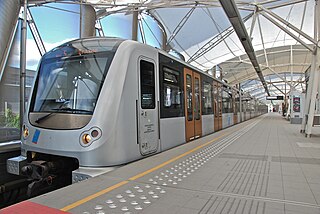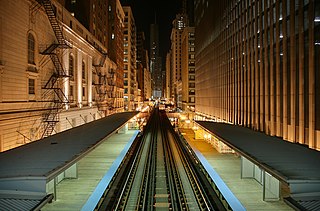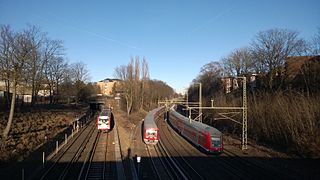

A premetro is a tramway or light railway which includes segments built to rapid transit standards, generally as part of a process of conversion to a metro-standards railway usually by the construction of tunnels in the central city area. [1] [2] [3]


A premetro is a tramway or light railway which includes segments built to rapid transit standards, generally as part of a process of conversion to a metro-standards railway usually by the construction of tunnels in the central city area. [1] [2] [3]
The first city to carry a portion of a streetcar line through the city center in a tunnel was Marseille, France, in 1893, with its Noailles subterranean station (see Marseille tramway). It was initially operated by horse-drawn wagons. The next prominent example was the Tremont Street subway (1897) in Boston, today part of the MBTA Green Line. These early tunnels were intended solely to reduce streetcar congestion on surface streets, not for later conversion to metro service. [4] Several early streetcar tunnels, including the Steinway Tunnel and East Boston Tunnel, were later converted to metro operation. However, the small loading gauge, tight curves, and steep grades of the streetcar tunnels required smaller metro cars than otherwise desirable. [4]
The modern premetro concept Stadtbahn began in 1960s Germany, as rising traffic congestion due to auto ownership led to the construction of new transit systems. Rather than building costly metro lines immediately, some cities built only the downtown tunnels. They could be used by existing tram lines in the short term, with the intention of full metro conversion later - hence "pre-metro". [5] The idea spread to other European countries in the 1970s, especially Belgium, where such systems were explicitly named premetros. [5]

A tram is a type of urban rail transit consisting of a rail vehicle, either individual railcars or self-propelled trains coupled by a multiple unit, that runs on tramway tracks on urban public streets; some include segments on segregated right-of-way. The tramlines or networks operated as public transport are called tramways or simply trams/streetcars. Many recently built tramways use the contemporary term light rail.

Light rail transit (LRT) is a form of passenger urban rail transit characterized by a combination of tram and rapid transit features. While its rolling stock is similar to that of a traditional tram, it operates at a higher capacity and speed and often on an exclusive right-of-way. In many cities, light rail transit systems more closely resemble, and are therefore indistinguishable from, traditional underground or at-grade subways and heavy-rail metros.

The Brussels Metro is a rapid transit system serving a large part of the Brussels-Capital Region of Belgium. It consists of four conventional metro lines and three premetro lines. The metro-grade lines are M1, M2, M5, and M6 with some shared sections, covering a total of 39.9 kilometres (24.8 mi), with 59 metro-only stations. The premetro network consists of three tram lines that partly travel over underground sections that were intended to be eventually converted into metro lines. Underground stations in the premetro network use the same design as metro stations. A few short underground tramway sections exist, so there is a total of 52.0 kilometres (32.3 mi) of underground metro and tram network. There are a total of 69 metro and premetro stations as of 2011.

Urban rail transit is a wide term for various types of local rail systems providing passenger service within and around urban or suburban areas. The set of urban rail systems can be roughly subdivided into the following categories, which sometimes overlap because some systems or lines have aspects of multiple types.
Various terms are used for passenger railway lines and equipment; the usage of these terms differs substantially between areas:

The Brussels tramway network is a tram system serving a large part of the Brussels-Capital Region of Belgium. It is the 16th largest tram system in the world by route length, in 2017 providing 149.1 million journeys over routes 140.6 km (87.4 mi) in length. In 2018, it consisted of 18 tram lines. Brussels trams are operated by STIB/MIVB, the local public transport company.

Stadtbahn is a German word referring to various types of urban rail transport. One type of transport originated in the 19th century, firstly in Berlin and followed by Vienna, where rail routes were created that could be used independently from other traffic.

Brussels-Schuman railway station is a railway station in the City of Brussels, Belgium, serving the European Quarter. It received its name from the area around the Robert Schuman Roundabout, itself named after Robert Schuman, one of the founding fathers of the European Union.

The Bochum-Gelsenkirchener Straßenbahnen AG, abbreviated BOGESTRA, is a public transport operator in the Ruhr area, most notably in the cities of Bochum, Gelsenkirchen and Herne. As of 2012, the company operated, in whole or in part, 9 rail lines, and 65 bus lines. In 2012, BOGESTRA transported a total of 144.9 million passengers. The company is a member of the Verkehrsverbund Rhein-Ruhr (VRR) public transport association.

The Premetro is a 7.4-kilometer long (4.6 mi) light rail line that runs along the outskirts of Buenos Aires, connecting with the Buenos Aires Underground line E, at Plaza de los Virreyes station and then to General Savio, with a short branch to Centro Cívico. It opened in 1987 and is operated by Metrovías. Originally, the Premetro was to include many more lines, but shortly after the privatisation of the railways the projects were postponed and never materialised and only "Premetro E2" was built.

Rapid transit or mass rapid transit (MRT), also known as heavy rail or metro, is a type of high-capacity public transport that is generally built in urban areas. A rapid transit system that primarily or traditionally runs below the surface may be called a subway, tube, or underground. Unlike buses or trams, rapid transit systems are railways, usually electric, that operate on an exclusive right-of-way, which cannot be accessed by pedestrians or other vehicles. They are often grade-separated in tunnels or on elevated railways.

Rapid transit in Germany consists of four U-Bahn systems and 14 S-Bahn systems. The U-Bahn, commonly understood to stand for Untergrundbahn, are conventional rapid transit systems that run mostly underground, while the S-Bahn or Stadtschnellbahn are commuter rail services, that may run underground in the city center and have metro-like characteristics in Munich, Hamburg and Berlin which they only have to a lesser extent in other cities. There are also over a dozen premetro or Stadtbahn systems that are rapid transit in the city center and light rail outside.

The Frankfurt am Main tramway network is a network of tramways forming a major part of the public transport system in Frankfurt am Main, a city in the federal state of Hesse, Germany.

Philippe Neerman (1930–2011) was a Belgian industrial designer and President of Industrial Design Planning Office Philippe Neerman & Co. N.V.\S.A. He was known for his application of ergonomics in public transportation systems and his work on major projects such as the Royal Library of Belgium, the Royal Castle of Laeken, and the Royal Palace of Brussels. He also participated in the international Design Biennale Interieur in Courtray, Belgium. He mainly focused on transportation and made designs for metros and trams including the Euro Tram, the Brussels Metro, and the Metro in Barcelona. His work has been incorporated into a diverse collection of museums, including the Ghent Design Museum.

The Essen Stadtbahn is a 19.6-kilometer (12.2 mi) light rail (Stadtbahn) network in Essen and the two neighbouring towns of Mülheim an der Ruhr and Gelsenkirchen in the German state of North Rhine Westphalia. It forms part of the Rhine-Ruhr Stadtbahn.
Light rail is a commonly used mode of public transit in South America. The term light rail was coined in 1972 by the Urban Mass Transportation Administration to describe new streetcar transformations which were taking place in Europe and the United States. The Germans used the term Stadtbahn, which is the predecessor to North American light rail, to describe the concept, and many in UMTA wanted to adopt the direct translation, which is city rail. However, in its reports UMTA finally adopted the term light rail instead.
The Vienna semi-metro tramway system was built on separated sections in the 1960s. The underground sections are called Untergrundstrassenbahn or sometimes abbreviated U-Strassenbahn, USTRAB or USTRABA . The semi-metro tunnels are maintained and used by the Wiener Linien, operator of the tramway lines. One section is used as well by the Wiener Lokalbahnen (WLB), the operator of a regional tram-train service.

Semi-metro is a form of public rail transport in which trams run partly on a conflict-free track, by using tunnels and/or viaducts. These stretches of track are designed to function like a regular metro or rapid transit line. Semi-metro lines run with tram cars because they are usually developed from an existing tram network.
This step-by-step planning approach to building rail rapid transit is known as pre-metro, implying the intention to ultimately construct a fully grade separated route to be used by rail rapid transit or metro trains.
PREMETRO—An LRT system designed with provisions for easy conversion into RRT (metro).
Cities such as Frankfurt and Cologne in West Germany have further developed their tramway system by introducing a concept known as "premetro." In this system trams or light rail vehicles make extensive use of tunnels, reserve track and by utilizing folding steps these vehicles can operate through high or low stopping places.
But instead of building the entire expensive systems immediately, the Germans hit on the idea of building only the city centre tunnels at first. Intended in the long run to be extended to full undergrounds, in the short term they could be used by trams which would continue to run on the surface outside city centres. The idea spread to other European countries, especially Belgium, where it became known as pre-metro. Today Brussels, Frankfurt, Stuttgart and many other cities are filling their central business districts with construction sites to move the trains underground.
Antwerpen rail network is a typical premetro network.
The Charleroi Metro is a typical prémétro network, i.e. trams that run underground in the city centre and on viaducts or separate right-of-way through outer parts (similar to German Stadtbahn systems).